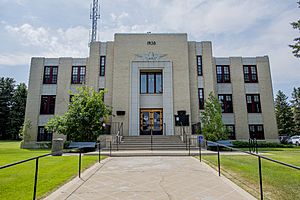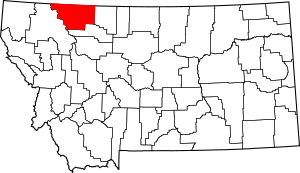Glacier County, Montana facts for kids
Quick facts for kids
Glacier County
|
|
|---|---|

Glacier County Courthouse in Cut Bank
|
|

Location within the U.S. state of Montana
|
|
 Montana's location within the U.S. |
|
| Country | |
| State | |
| Founded | 1919 |
| Named for | The glaciers in Glacier National Park |
| Seat | Cut Bank |
| Largest city | Cut Bank |
| Area | |
| • Total | 3,037 sq mi (7,870 km2) |
| • Land | 2,996 sq mi (7,760 km2) |
| • Water | 41 sq mi (110 km2) 1.40% |
| Population
(2020)
|
|
| • Total | 13,778 |
| • Density | 4.5367/sq mi (1.7516/km2) |
| Time zone | UTC−7 (Mountain) |
| • Summer (DST) | UTC−6 (MDT) |
| Congressional district | At-large |
|
|
Glacier County is located in the U.S. state of Montana. As of the 2020 United States Census, the population was 13,778. The county is located in northwestern Montana between the Great Plains and the Rocky Mountains, known to the Blackfeet as the "Backbone of the World". The county is geographically and culturally diverse and includes the Blackfeet Indian Reservation, Glacier National Park, and Lewis and Clark National Forest. The county is bordered by 75 miles of international boundary with two ports of entry (Piegan and Del Bonita) open year-round and one seasonal (Chief Mountain) international border crossing into Alberta, Canada.
Contents
Settlements
Five small communities and two incorporated towns are located within the county.
Cut Bank is the county seat with a population of approximately 3,500 residents. It is located at the east end of the county at the start of the Great Plains. Cut Bank sprang up around the railroad and agriculture needs of the surrounding area and also reflects part of a large oil boom in the early part of the century. The diverse population is the result of this settlement. Town resources include a hospital and clinic, a historic airport with regional and international connections, a nine-hole golf course, and a swimming pool. Nearby sites of the Louis and Clark expedition and other historic and prehistoric sites can be visited. The Glacier County Museum has a collection of area artifacts, historic buildings, community memorabilia, and a comprehensive archive of early area history and individuals, including a large collection of data on Blackfeet history.
Browning is the home and government seat of the Blackfeet Tribe. The incorporated portion of Browning, at 1,400, does not reflect the population of 7,000 in the community that is largely representative of the Blackfeet Tribe on a part of their ancestral homeland dating back over 5,000 years. Town resources include a federal building, community college, Native American Museum and Heritage Center, casino, fairgrounds, race track, and Native American camp area that hosts an annual Native American celebration and pow-wow. Many events center on this area during the summer months. Blackfeet tribal fishing and recreational permits, along with guide and tour services to blue ribbon trout fishing and other recreational opportunities, can be found there.
Babb is a small unincorporated farming and ranching community on the Blackfeet Indian Reservation. The community experiences a large influx of tourists in the summer months as it is the gateway to the Many Glacier area of Glacier National Park. Community infrastructure includes one school (Babb Elementary [1] School), a U.S. post office [2], a fire station that houses the Babb/St. Mary Volunteer Fire Department [3], Thronson's General Store and Motel [4], several restaurants, two churches, and a gas station. Nearby attractions include Glacier National Park [5], the Many Glacier Hotel, the St. Mary River, the St. Mary Irrigation Canal, Chief Mountain, and the U.S. ports of entry of Piegan and Chief Mountain.
East Glacier Park Village, a small winter community, grows in the summer with many visitors and the summer help from all parts of the globe that meet the needs of the larger population. It is the site of the largest of Glacier Park’s historic hotels and fleet of “red buses”. There is a nine-hole golf course, campgrounds, trail rides, boat rides, native interpretive tours and other recreational activities located at this stop on the railroad.
St. Mary is an unincorporated community on the western border of the Blackfeet Native American Reservation adjacent to Glacier National Park. The village is the eastern terminus of the Going-to-the-Sun Road which bisects the park east to west, a distance of 53 miles (85 km). Fewer than 50 people reside in the village year-round; however, the population increases tenfold on a busy summer evening. Several lodges, restaurants and cafés, a small grocery store, two gas stations and campgrounds are located in the village. A large housing area for National Park Service personnel is located adjacent to the village, but within the park. U.S. Route 89 passes through the village, which lies between Saint Mary Lake in Glacier National Park and Lower St. Mary Lake on the Blackfeet Native American Reservation.
Starr School is a census-designated place (CDP) in Glacier County, Montana, United States. The population was 248 at the 2000 census.
Geography
According to the U.S. Census Bureau, the county has a total area of 3,037 square miles (7,870 km2), of which 2,996 square miles (7,760 km2) is land and 41 square miles (110 km2) (1.3%) is water. About 70.85 percent of the county's land area lies within the Blackfeet Indian Reservation. Another 20.58 percent lies within Glacier National Park at the county's extreme west. The balance of the county, the extreme eastern section, is centered on its largest city, Cut Bank.
Adjacent counties
- Flathead County, Montana - west
- Pondera County, Montana - south
- Toole County, Montana - east
- Cardston County, Alberta - north
- Improvement District No. 4, Alberta (Waterton Lakes National Park) - northwest
- County of Warner No. 5, Alberta - northeast
National protected areas
- Glacier National Park (part)
- Lewis and Clark National Forest (part)
Demographics
| Historical population | |||
|---|---|---|---|
| Census | Pop. | %± | |
| 1920 | 4,178 | — | |
| 1930 | 5,297 | 26.8% | |
| 1940 | 9,034 | 70.5% | |
| 1950 | 9,645 | 6.8% | |
| 1960 | 11,565 | 19.9% | |
| 1970 | 10,783 | −6.8% | |
| 1980 | 10,628 | −1.4% | |
| 1990 | 12,121 | 14.0% | |
| 2000 | 13,247 | 9.3% | |
| 2010 | 13,447 | 1.5% | |
| 2020 | 13,778 | 2.5% | |
| US Decennial Census 1790-1960 1900-1990 1990-2000 2010-2020 |
|||
2010 census
As of the 2010 United States Census, there were 13,399 people, 4,361 households, and 3,088 families residing in the county. The population density was 4.5 inhabitants per square mile (1.7/km2). There were 5,348 housing units at an average density of 1.8 per square mile (0.69/km2). The racial makeup of the county was 65.6% Native American, 31.1% white, 0.2% Asian, 0.1% black or African American, 0.2% from other races, and 2.8% from two or more races. Those of Hispanic or Latino origin made up 1.8% of the population. In terms of ancestry, 13.6% were German, 7.2% were Irish, 5.6% were Norwegian, and 1.4% were American.
Of the 4,361 households, 44.0% had children under the age of 18 living with them, 42.8% were married couples living together, 19.1% had a female householder with no husband present, 29.2% were non-families, and 24.9% of all households were made up of individuals. The average household size was 2.91 and the average family size was 3.49. The median age was 31.7 years.
The median income for a household in the county was $38,075 and the median income for a family was $44,397. Males had a median income of $31,700 versus $30,594 for females. The per capita income for the county was $17,053. About 21.4% of families and 25.4% of the population were below the poverty line, including 35.0% of those under age 18 and 12.9% of those age 65 or over.
Communities

City
- Cut Bank (county seat)
Town
Census-designated places
- Babb
- East Glacier Park Village
- Little Browning
- North Browning
- Santa Rita
- South Browning
- Starr School
Unincorporated communities
- Meriwether
- St. Mary
See also
 In Spanish: Condado de Glacier para niños
In Spanish: Condado de Glacier para niños

